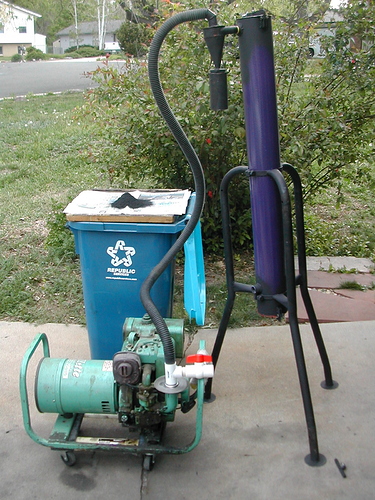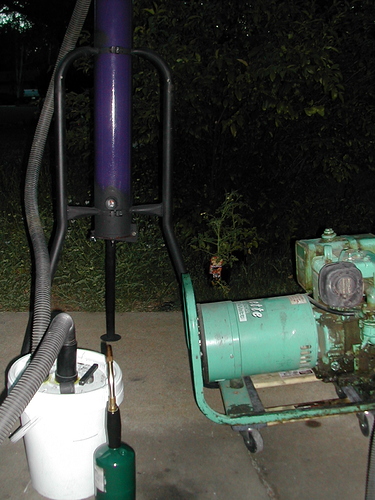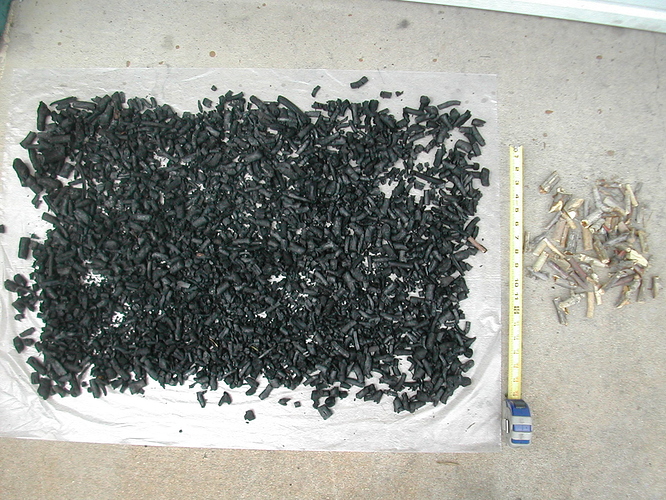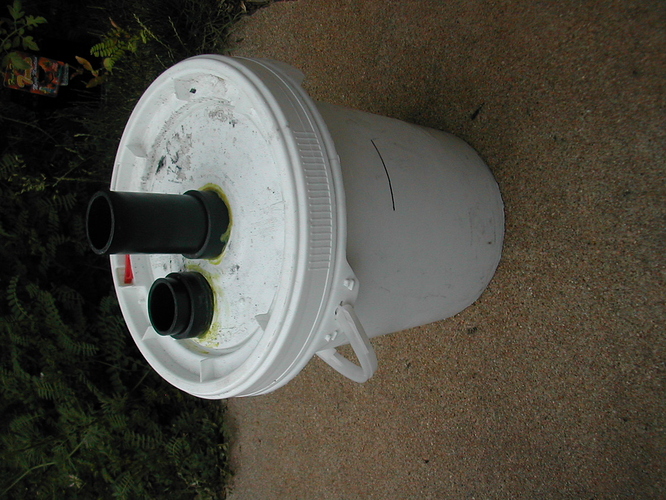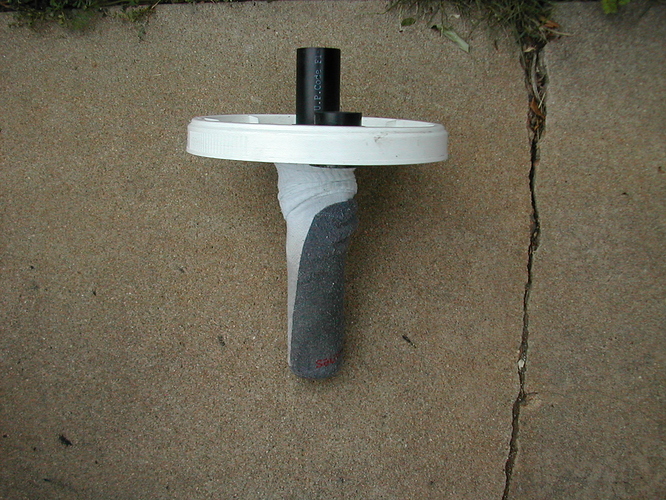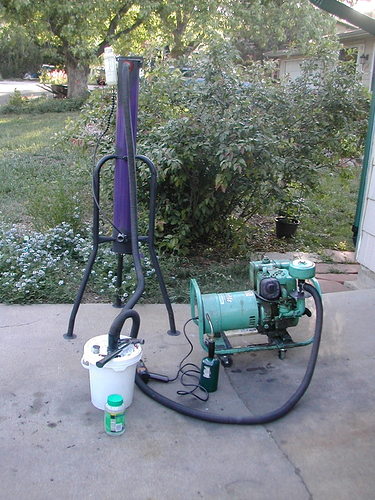Very nicely thought out system. The wheel borrow wheel and handles to the spring loaded legs. And of course the gasifier. TomC
Kyle, you two have nice setup there and what Tom said.
Bob
That is, all together, a pretty spiffy system you guys got there!.
Hi Kyle, Congrats on the wodgas. And what’s the song lyric, “teach your children well”. Nice post, darn, left over oak wood.
Pepe
Hi All,
Asking for help. I made this charcoal gasifier and tried to run it today. I think it was working for about a minute. Then, I think the carburetor clogged with dust. The cyclone seemed to work, because the catch can was almost completely full of dust. I dumped it out on the newspaper. The inside diameter of the big pipe is 4.75 inches. The inlet nozzle for combustion air is .78 inches. The gas outlet is also .78 inches. The cyclone diameter is 3 inches. I think perhaps I filled the column too high. I will clean the carburetor, take some charcoal out of the column, and try again tomorrow. This a 1960s Briggs, 7 hp, 275 cc, 3600 rpm.
Rindert
Did I miss it, or are you not running through a filter? I would run through a hay, or foam filter if the gas is cool enough.
Yes, as Al noted, you need a filter. Cyclones are great for catching the big stuff, not so good for the tiny particles. There are lots of adequate filter options. By catching the big stuff, a cyclone will help your filter last longer but, will not replace it.
Rindert, I really like the look of your gasifier and believe it will probably do a good job. Instead of lowering the charcoal level too much, just top-off the charcoal with some stainless steel scouring pads to keep the smallest fuel-sized pieces from passing into the cyclone. You will still need a post-cyclone filter with foam rubber, oil, towel, hay, charcoal granule, perlite, fiberglass, water, electrostatic, etc.
I have another thought (can you tell that I’m excited by your progress?). If you don’t need dual fuel, remove the carburetor for better gas flow. Close your spark plug gap by c20% (.025 instead of .032) and keep a clean replacement spark plug ready. If this engine has external points, like my Onan generator, you can adjust the points gap while running to get maximum speed.
Al,
I think the gas is fairly cool because it didn’t melt the plastic shop vac hose.
Bruce
Thanks for the tip about the stainless steel scouring pads. I might actually need stainless steel wool, because I beat all the charcoal so it would pass a 1/4" mesh. There’s a lot of dust in it. this was because of something Koen said a long time ago about smaller size making a smaller, hotter reaction zone. But maybe too small. And I washed it before I ground it, thinking it would keep some of the dust down, and remove dirt and ash. Maybe now its biochar so I’ll just spread it on the grass. 
Thanks for the tips about the spark gap, and removing the carburetor. But if I can I want to keep the capability of running the generator, therefor wanting to keep the governor intact so its hard to replace the carburetor. And would also be nice to be able to still use gasoline. It uses magneto ignition.
Thanks,
Rindert
You didnt screen the dust out? Small is good but dust is not. It can allso plug the entire gasifier.
My bet is your Cyclone was adequate but it filled up fast. Screen the char and put a aditional filter and you good to go. I am a fan of sack filters. Super easy and preety much 100% efficient. It allso has a side benefit if you use felt. It will clog up with tar in case you make any and save your engine.
Looking good thugh!
Charcoal between 3/4"and 1/4" will run well. Perhaps Koen would say that between 1/2" and 1/8" will work better. I believe there is consensus that anything below 1/8" is considered unacceptable. The reactor needs to breathe, so fuel must be classified to eliminate pieces too big AND too small.
It runs, but I only get about 1/4 of the 3000 watts the generator is rated for. I put in large charcoal. It doesn’t seem to make much dust anymore. I made a different filter and took the cyclone off. What you see are four socks covering a pipe with holes in it. The pipe is open at the bottom. The filter bucket collects a little water. I still feel that there is too much flow resistance. I’ll empty the column tomorrow and see whats in there.
I added a water drip and increased power to about 40% of what the generator is rated for. Does anyone know how to change the ignition timing on these old magneto engines?
Rindert
You can use an offset flywheel key. That will advance your timing a few degrees, which would help. I found this site for B&S Raptor (5hp flathead) keys. You might have to make / modify to fit your engine, but you get the idea.  keep in mind that your engine’s timing might be different, I have not actually tried this. I just know that a sheared flywheel key makes for a non-running engine!
keep in mind that your engine’s timing might be different, I have not actually tried this. I just know that a sheared flywheel key makes for a non-running engine!
https://out2win.com/catalog/raptorfly.html
[edit] older small engines have breaker points which can be adjusted. You may want to connect a continuity meter (battery and buzzer or flashlight bulb) to see where the points open and close, to see what your changes are relative to top dead center…
“edit” #2: thinkng about it, you might have to do both flywheel key and breaker points to make it run right.  If I remember right, the spark happens when the points open.
If I remember right, the spark happens when the points open.
Gary and I both did some load testing at last years Argos event, We both were only able to achieve 30 to 40 percent of the generators ratings. We both had similar 400 cc engines I had the 9000 Harbor Freight model. But realistic continuous rating is around 6000 to 6500 watts. I was only able get 2400 watts consistently with 3000 to 3500 peak. I think Gary’s set up was around the same. My machine was experimental but this about what the refined production systems get. So going charcoal now 
I seem to be able to get a solid 1200 watts out of the 3000 (rated) brush generator. Want to get a better metering valve. I about put out the fire at one point. 
So maybe I should just be happy with my 40 percent. I had the notion that this old flat head type machine would do a little better, just because the combustion chamber shape would seem to be less favorable to high flame speed gasoline than to chargas.
I suppose there are people out there building arduino and microchip based ecus for these things?
Rindert

